Raising Water Consciousness through
World’s Biggest Photo Exhibition and
Largest collection of Photo Stories on Water
Photo Stories | Water and Livelihood
Managing Water Abundance below the Sea Level for Livelihood in Kuttanad, Kerala
Nandita Singh and Om Prakash Singh
15 December, 2018
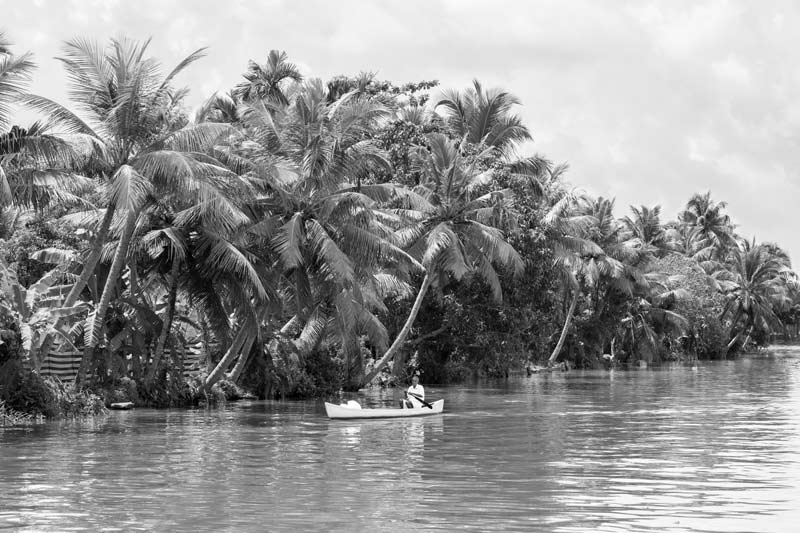
Kuttanad wetland in Kerala – a segment of the larger Vembanad-Kol Wetlands in India, a famous Ramsar site - is a deltaic floodplain drained by the rivers Pamba, Achencoil, Manimala and Meenachil. These rivers confluence into the adjoining Vembanad Lake before meeting the Arabian Sea. Kuttanad lies in a high rainfall zone where the average annual rainfall is more than 3,000 mm and a major part of the region is located below the mean sea level. These features make Kuttanad a zone of water abundance, with substantial areas remaining submerged for a large part of the year. In this inhospitable environment, human populations have ingeniously designed an exclusive set of adaptations to enable them to survive, thrive and develop. The lifestyle adopted by the people of Kuttanad represents a unique human-nature-water complex which has been presented in the previous photo story dated 15 November 2018. An important and interesting question concerning the life below the sea level in Kuttanad is: what gainful livelihood strategies are feasible amidst water abundance? As indicated in the previous story, the colonizers of Kuttanad wetland devised a unique system of paddy cultivation below sea level as their major livelihood activity and this is the only place in the world where paddy is being cultivated below the sea level. The region contributes about 25% of the total rice production in the State, bringing it the title of the 'rice bowl of Kerala'. Besides paddy, Kuttanad inhabitants also developed ingenious ways of farming crops like coconut, banana and cassava, which ordinarily do not grow well under waterlogged conditions naturally prevailing in Kuttanad. Allied livelihood strategies also include fishing in the rivers, their channels and the Vembanad Lake, and fish farming in the paddy fields. The history of paddy cultivation and the allied livelihood activities in Kuttanad is said to be centuries old, when these took root in some natural formations in the upland areas of the region caused by silt and sand deposits brought by the rivers. However, the 'golden era' of paddy-based agriculture began more recently in the 19th century when reclamation of land from shallow stretches of Vembanad Lake and the periphery of river Pamba was initiated on a large-scale with financial and administrative support from the Travancore State, of which Kuttanad was a part. Paddy farming, together with the allied activities as above, constitutes the unique 'Kuttanad Wetland Agricultural System' which has been declared by the FAO as a 'Globally Important Agricultural Heritage System'. Besides, other livelihood activities related to the water abundance such as duck farming and backwater tourism have come to be integrated in the recent decades. This photo story aims to present glimpses of the ingenious strategies adopted by the industrious inhabitants of Kuttanad for practicing agriculture and other livelihoods by managing the water abundance below the sea level. The title photo depicts plantations of coconut and banana next to Vembanad Lake in the 'Kayal lands' of Kuttanad which have been reclaimed from the shallow stretches of the Lake in Alappuzha district, Kerala.
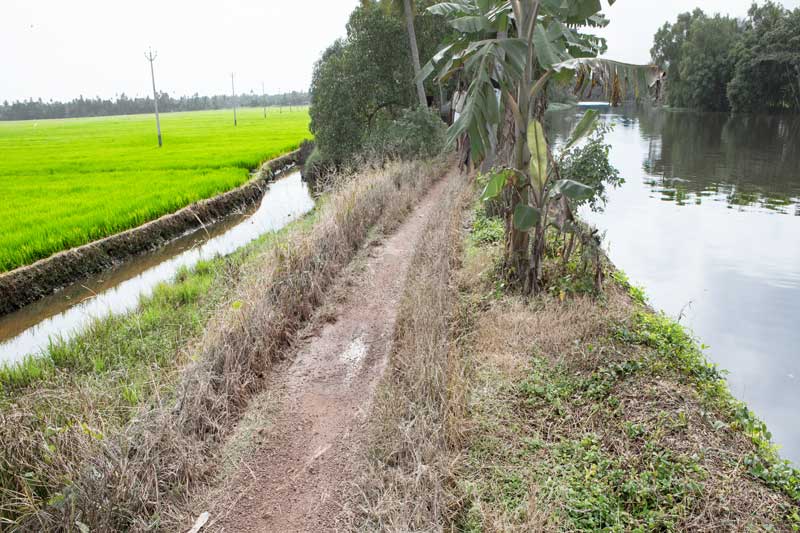
Outer and inner embankments created along the banks of a channel of Pamba river for paddy cultivation in Alappuzha district, Kerala
The secret of agriculture and self-sustaining livelihoods amidst water abundance below the sea level in Kuttanad lies in the construction of embankments. Embankments are instrumental in creation of arable land where either deep-lying paddy fields are located or raised 'garden lands' have been built. These generally consist of an outer embankment and an inner ring bund. The outer embankment is the primary protection of a large plot of land against the prevailing water abundance, inside which blocks of paddy fields (called 'padshekharam'), garden lands or habitations may be located. Construction and maintenance of embankments is a skillful art based on collective labor. For constructing the outer embankment, which is often 1.5 m to 2.5 m wide, a frame is first set at the selected location using bamboo, coconut and aracanut poles and mats, followed by filling up with sand and high-quality clay from the lake bottom placed within layerings of sedge and other kinds of weeds. The inner ring bunds, which serve to separate adjacent fields are smaller, being generally less than half a meter high and less than one-meter wide, and primarily made up of mud taken from the field itself. Since bunds often breach during high flood and high tides, their regular maintenance is necessary. Over the last 3-4 decades, for minimizing the risk of breach and crop loss, outer bunds are being increasingly protected by permanent granite pitching.
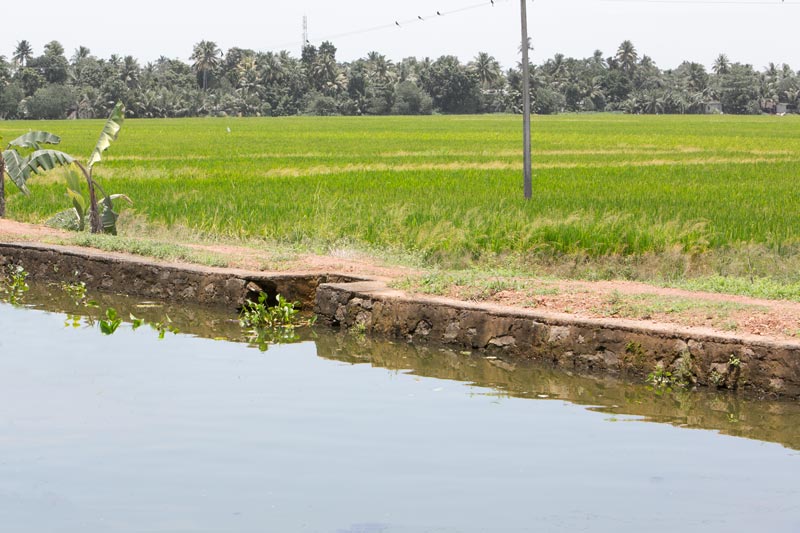
Embankment and padshekharam in 'Kayal' lands reclaimed from shallow stretches of Vembanad Lake in Alappuzha district, Kerala
In Kuttanad agricultural lands have been created amidst water abundance in different zones. It is estimated that about 550 sq.km. land is reclaimed from Vembanad Lake and floodplain marshes of the four rivers Pamba, Achenkoil, Manimala and Meenachil. Of this, the land reclaimed from the lake bed itself is the lowest, and classified as 'Kayal' land, shown in the above photo. In the immediate vicinity is Lower Kuttanad, which lies 1-2 m below mean sea level, and the two zones together are estimated to have a total extent of 257 sq. km. Upper Kuttanad, North Kuttanad, Purrakad Kari and Vaikom Kari are lands reclaimed from floodplain marshes and believed to extend over 293 sq.km. Here the height varies between 0.5 m below sea level to 1 m above sea level. Despite being higher, considering the high flood risk, artificial embankments for protecting agricultural fields and garden lands exist here.
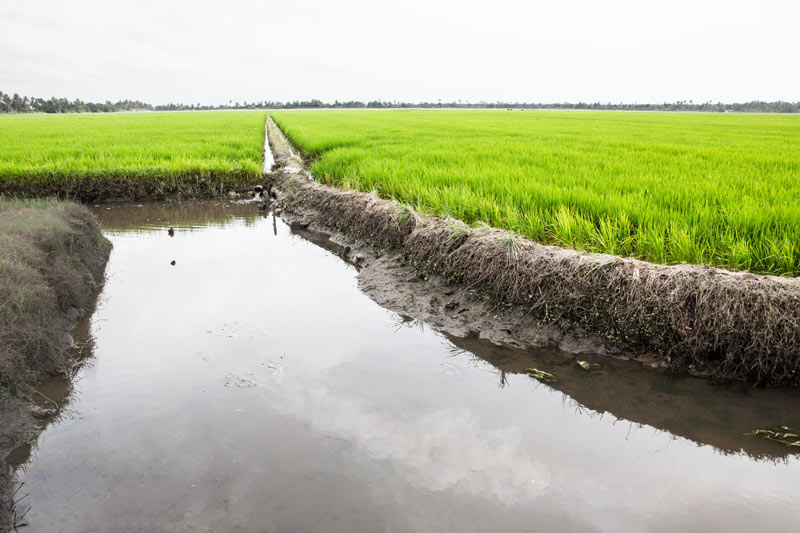
A water channel between the inner ring bund surrounding a paddy field and the outer embankment in Alappuzha district, Kerala
Paddy (Oryza sativa) is the most important crop produced below the sea level in Kuttanad through a special process of water management. This involves removing the excess water ('dewatering') or bringing water in ('irrigating'), depending upon the need of the cropping cycle. In between the inner bund and the stronger outer embankment exist water channels, as shown in the above photo. These serve two important functions with respect to managing the water abundance for agriculture. First is their role during the phase of dewatering when these receive the excess water pumped out from the paddy fields. Second is their role in irrigation when they hold water received from the river channel or lake through the sluices in the outer embankment, which is then applied to the crop in the fields. Regular desilting of the water channels is an important activity in the process of managing water abundance for agriculture in Kuttanad and is carried out collectively by the farmers.
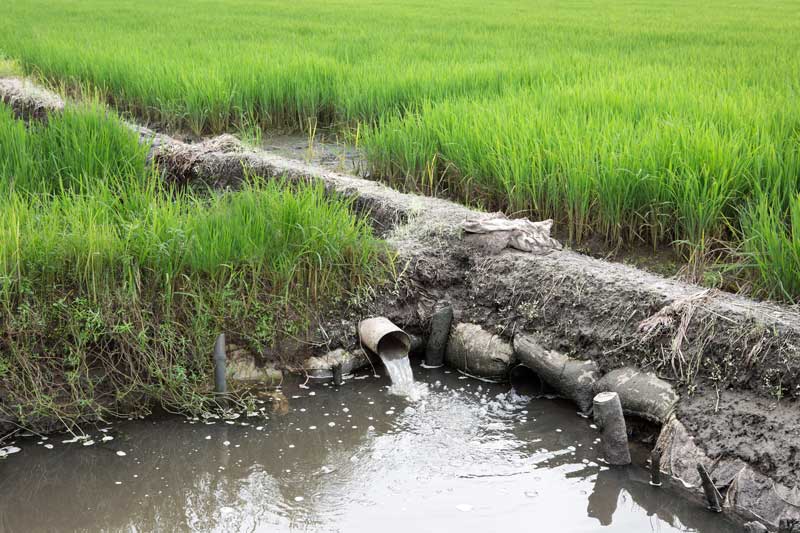
Excess water being removed from paddy fields located in a padshekharam in Alappuzha district, Kerala
Since the paddy fields are ordinarily located up to or even more than 2 m below the surrounding water level, removing the excess water that is naturally present in the fields is one of the most essential steps in the process of paddy cultivation below sea level. Dewatering is thus done before the first ploughing as well as several times during the cropping cycle. Important phases for dewatering during the cropping cycle include the stage after sowing, during different stages of tillering, and before harvesting. The water removed from the field is allowed to flow out into water channels between the inner ring bund and the outer embankment, as shown in the photo above.
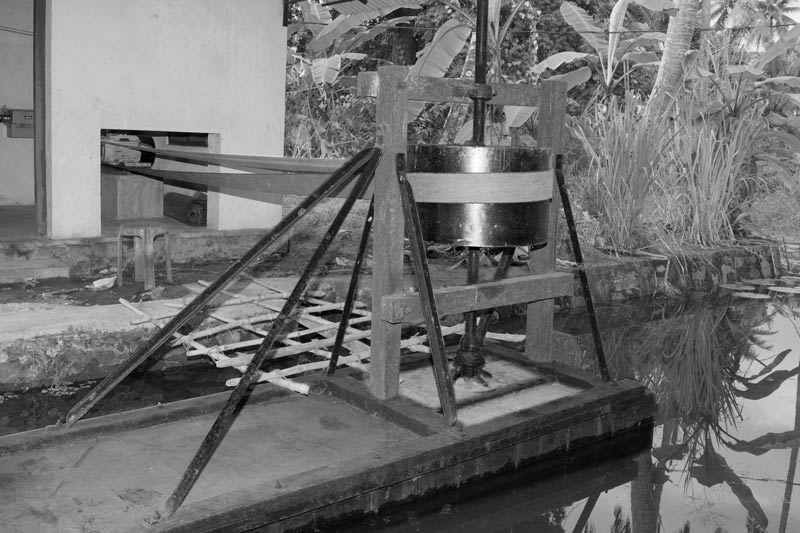
An axial flow pump used for dewatering paddy fields in Kottayam district, Kerala
Given the depth of the paddy fields, dewatering involves removal of large quantities of water. Traditionally this was done using a device called 'chakram', a multi-pedal heavy wheel of large diameter with wide blades. A chakram needed to be continuously pedaled by several men for 2-3 weeks to completely bail out water from a field. In present times, dewatering is carried out using axial flow pumps. The locally innovated axial flow pump called 'petti and para' (box and drum), shown in the above photo, is unique to the Kuttanad region in India, being used for 'pumping out' water from agricultural fields rather than 'pumping-in'. It is commonly driven by 10 Hp - 50 Hp motor and has been widely in use since the latter half of the last century. Axial flow pumps of smaller capacity such as 10 Hp can be used for dewatering fields 10 ha in size and often individually owned. Larger ones, driven by 50 Hp motors and usable on areas as big as 50 ha, are owned and maintained by local farmers' societies (called Samithy).
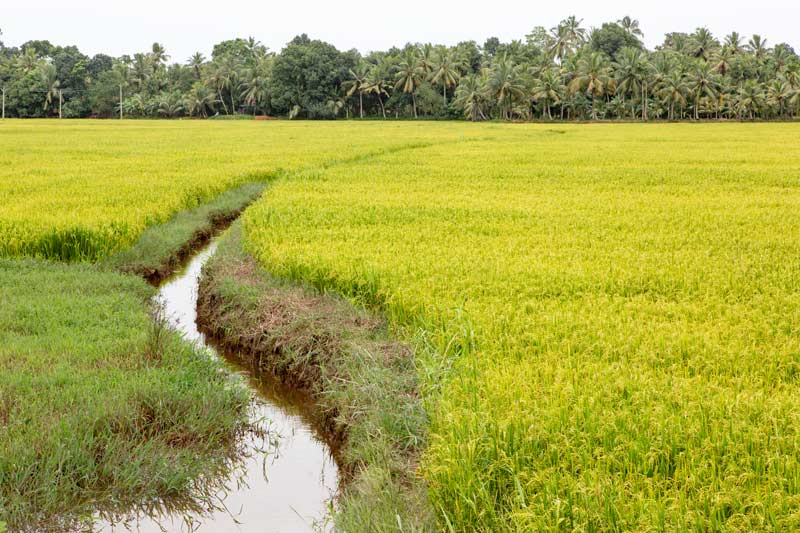
Paddy fields inside a padshekharam separated by a water channel in Alappuzha district, Kerala
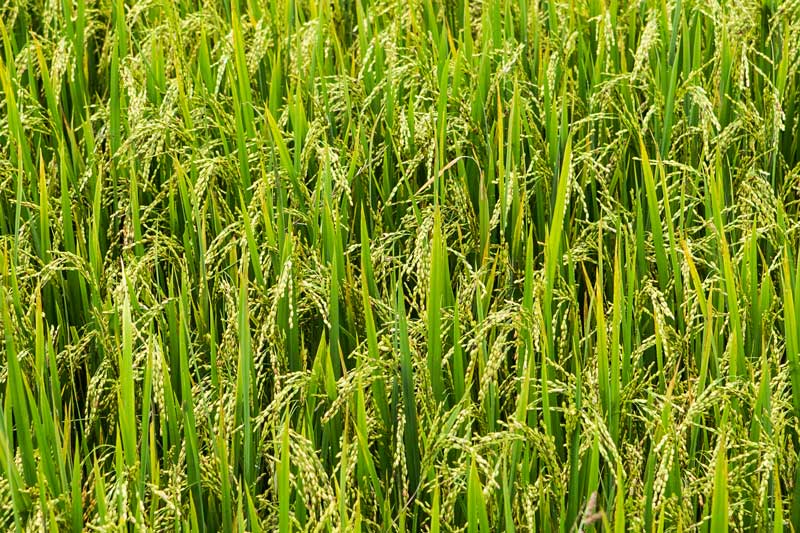
Paddy crop in a padshekharam in Alappuzha district, Kerala
It is estimated that about 18% of the paddy growing area in Kerala lies in Kuttanad in the form of 1,350 padsekharams. The major paddy crop in the region is called 'punja' which is sown post-monsoon (November-December) and harvested before the onset of dry season (March-April). Punja used to be the only paddy crop traditionally grown every three years, but at present 2-3 paddy crops are grown in a year by the industrious farmers of Kuttanad. According to one estimate, about two hundred thousand tonnes of rice is annually produced in Kuttanad.
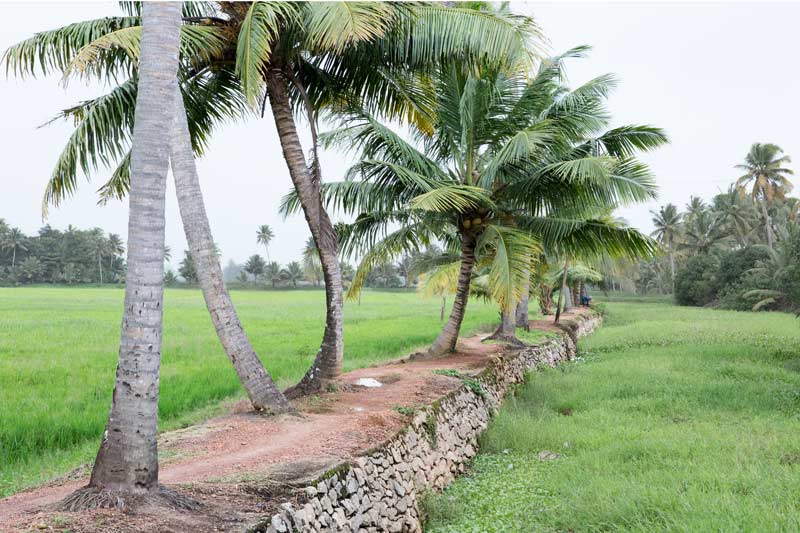
Coconut plantation on a bund between paddy fields in Alappuzha district, Kerala
Coconut (Cocos nucifera) is the second most important crop raised for livelihood in the Kuttanad agricultural system. The Kuttanad wetland provides suitable growth conditions for the coconut palm, with temperature between 20° to 32° C, and rainfall in the range of 1,000 to 3,000 mm/year. However, coconut palm cannot withstand waterlogging which is the characteristic feature of Kuttanad since the roots start rotting in water. In order to overcome this limitation, the inhabitants of Kuttanad ingeniously developed the art of growing coconut palms on raised bunds. Coconut plantations are thus commonly developed on bunds between paddy fields, as shown in the photo above. From an average plantation of 15-20 coconut palms, 1,000-1,200 nuts can be harvested per year.
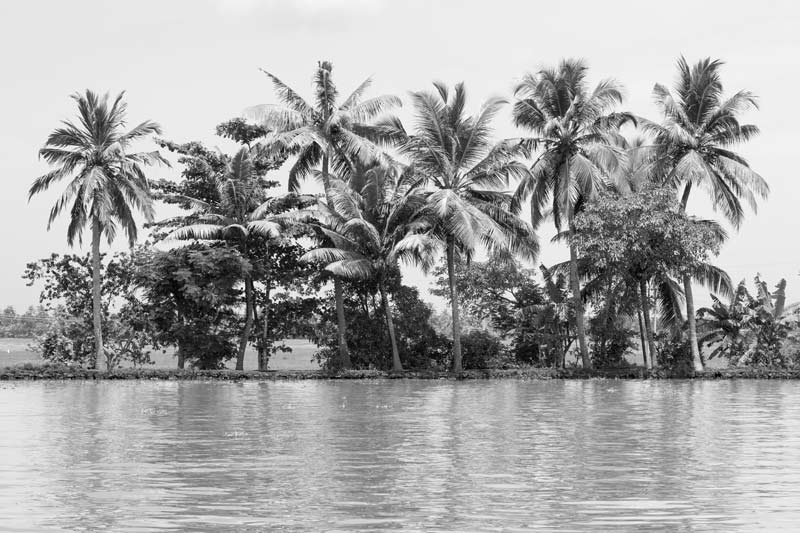
Coconut plantation on a patch of garden land reclaimed from Vembanad Lake in Alappuzha district, Kerala
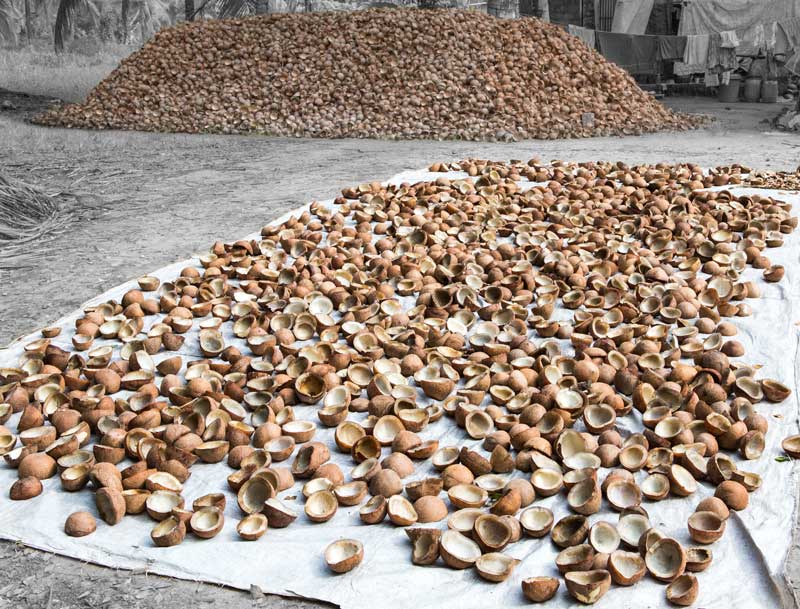
Coconut fruits being sun-dried to produce copra in Kottayam district, Kerala
Coconut is an integral part of the traditional food basket of Kuttanad inhabitants, but more importantly it has great commercial value. Among important coconut products in Kuttanad are copra, oil, toddy, coconut water and coir which are sold in the domestic as well as export market. A large percentage of the matured nuts are converted into copra by mainly sun-drying them as shown in the photo above. The copra may be used for extracting oil or retained as edible ball copra. Coir, produced by retting of coconut husk in water is also an important economic activity in the region.
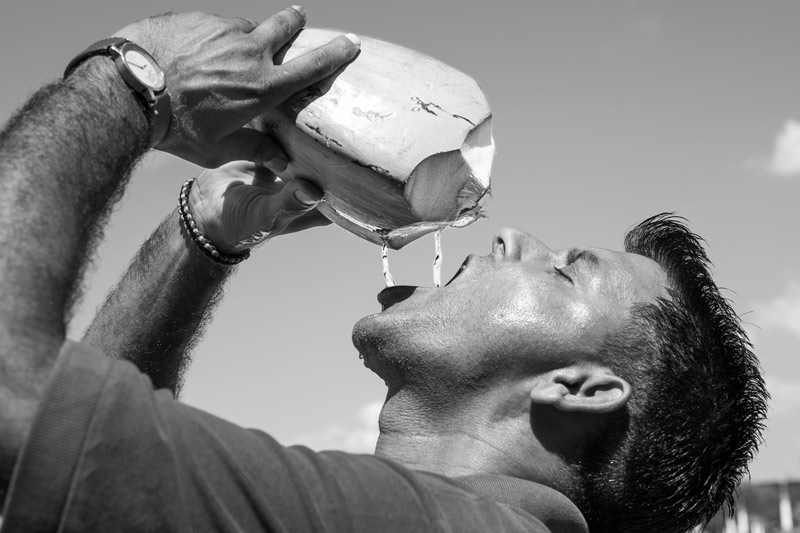
Water from young coconut as a popular drink in Kottayam district, Kerala
Coconut water, also called coconut juice, is the clear liquid inside the young green fruit of the coconut palm. Coconut water is becoming a popular drink, marketed as a natural energy or sports drink having low levels of fat, carbohydrates, and calories. It is sold locally as well as exported outside the region and/or State.
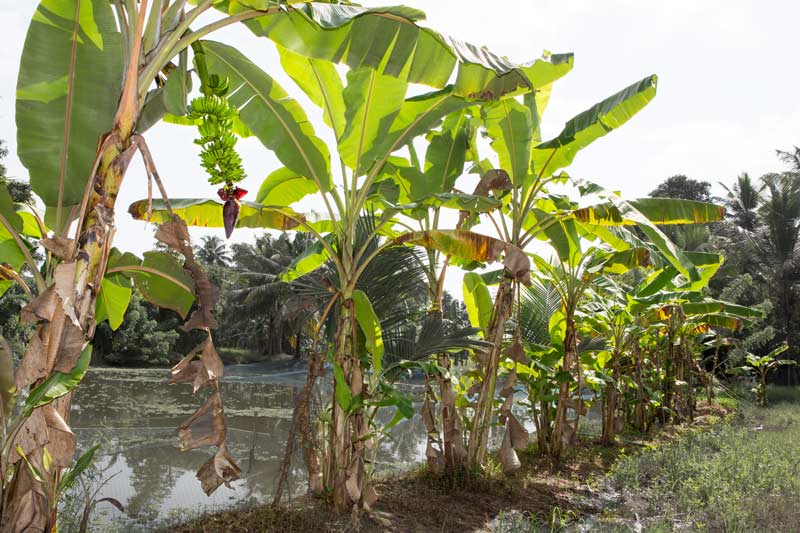
A banana plantation on a bund surrounding a paddy field in Alappuzha district, Kerala
Banana (Musa paradisiaca) plantation is another important source of livelihood for Kuttanad inhabitants, developed amidst water abundance in a manner similar to coconut plantations. Since banana plants cannot tolerate waterlogging because the roots rot in water, these are grown on bunds situated between or next to paddy fields. These are also raised together with coconut, cassava and other plants inside homestead gardens. Banana is a very popular fruit in the region that is consumed in fresh or cooked form both as ripe and raw fruit. Besides, processed products from the fruit such as chips are common. Additionally, the tender stem and the inflorescence, shown together with fruits in the above photo, can be used as vegetable. Besides, banana fibre is used to make items like bag and wall hangers while banana leaves are popularly used as eating plates. The various products from banana plantations are consumed or sold locally as well as exported.
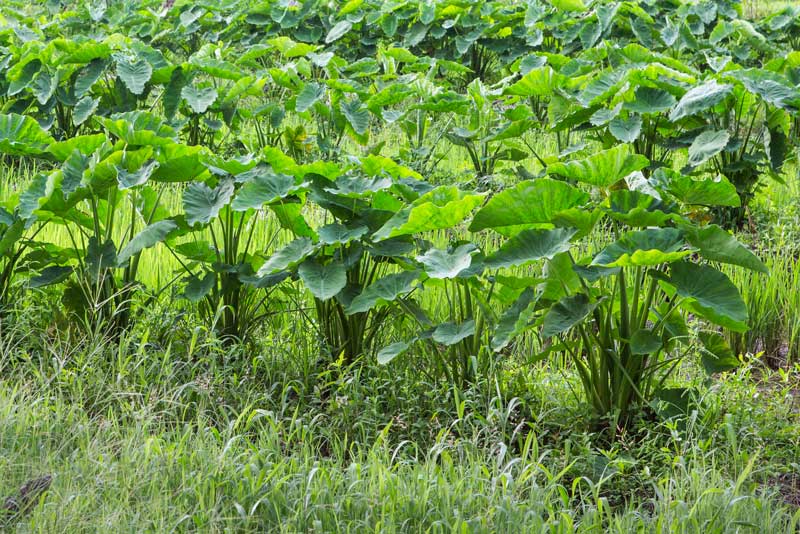
A field of Colocasia in Alappuzha district, Kerala
Colocasia (Colocasia esculenta) is grown as an important foodcrop in Kuttanad. These are grown in single-crop farms as shown in the photo above, or in mixed gardens together with coconut, banana and other plants. As with coconut and banana, stagnant water sites are not suitable for growing colocasia because the tuber (root) may rot more easily in these conditions. Consequently, in Kuttanad, colocasia is mostly grown in the garden lands. The tuber of the plant as well as leaves are used as vegetable and consumed at home or sold in the market.
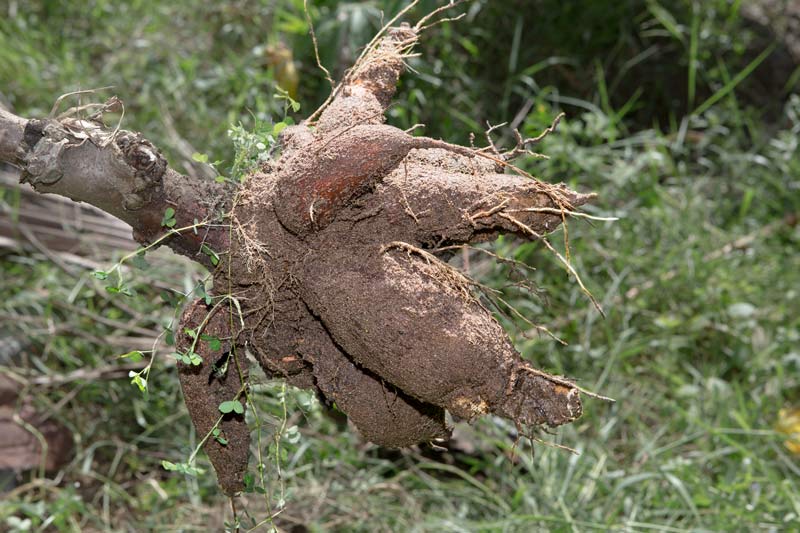
A freshly uprooted crop of Cassava in Alappuzha district, Kerala
Cassava (Manihot esculenta), also known as tapioca, is another important tuber grown in the garden lands in Kuttanad. Cassava may be used locally as a vegetable or commercially used for producing starch powder and tapioca pearls sold in the market.
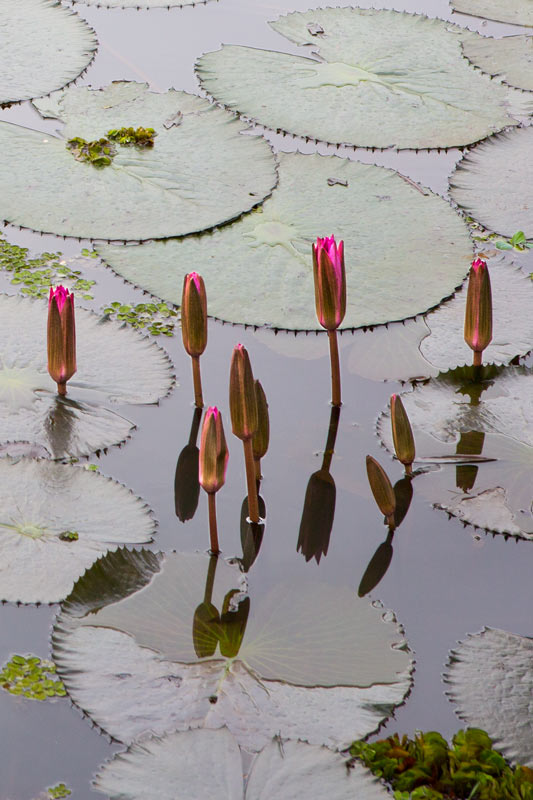
Lotus flowers blooming in a pond in Alappuzha district, Kerala
The water abundance has been well utilized by Kuttanad inhabitants to grow and harvest 'Lotus' (Nelumbo nucifera). This plant grows naturally as well as cultivated by some farmers in the local water bodies including ponds and paddy fields. The flowers and buds of lotus are of great demand in the market, frequently used for religious offering. In addition, the stem and root of the plant are edible and used as vegetables.
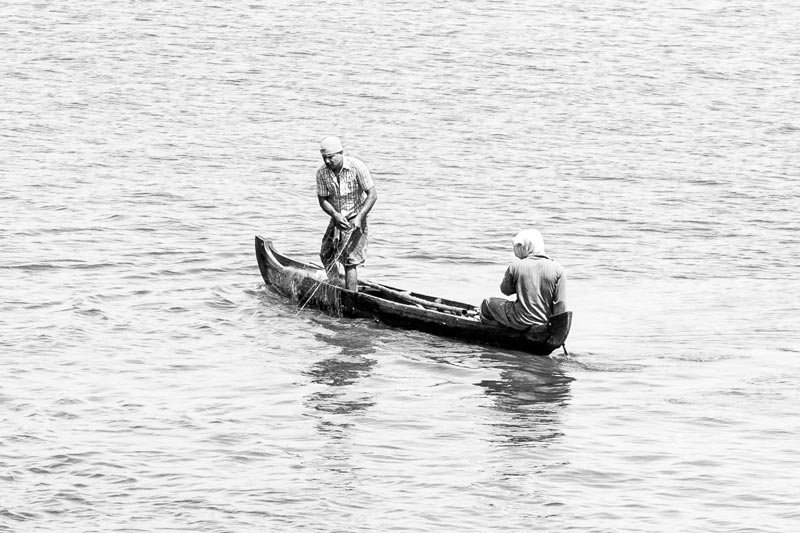
Fishing in Vembanad Lake in Alappuzha district, Kerala
The inhabitants of Kuttanad have very efficiently managed the water abundance for maximizing benefits with regard to fish. Large expanse of water comprising the river networks and the lake, spread over roughly 13,000 ha are actively used for fishing and other water-based livelihoods. The region is home to more than 67 species of fin fishes and 14 species of shell fishes, including shrimp, prawn and crab. The Vembanad Lake offers an important venue for fishing in natural waters, and local fishermen catch many varieties there, selling them in the local market as well as exporting outside. Fish production in the entire Vembanad-Kol wetland has been estimated to 7,200 tons per annum, of which up to 40%-50% is known to have come from Kuttanad until recently. More than 30% of the lake's fin fish fauna is represented by catfishes belonging to different families, besides cyprinids, snake fishes, cichlids and glass fish of different species being common.
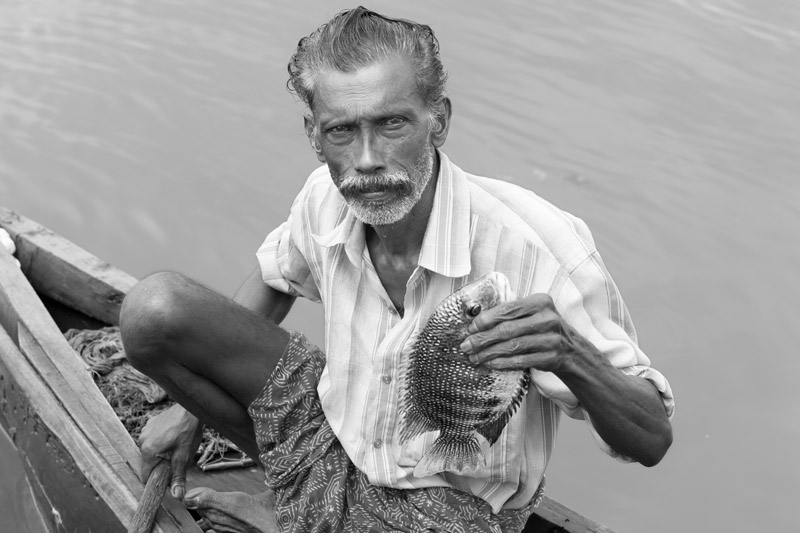
Karimeen (pearl spot fish) caught in Vambanad Lake in Alappuzha district, Kerala
Fish forms an important part of the traditional diet, with Karimeen (Etroplus suratensis), shown in the above photo, as a popular variety. This fish is found in Vembanad Lake as well as farmed in local ponds and paddy fields. The body is oval in outline and covered over with scales of black colour, hence the name Karimeen (meaning 'black fish' in the local language Malayalam). There are eight transverse bands on the body and a few irregular black spots on the abdomen.
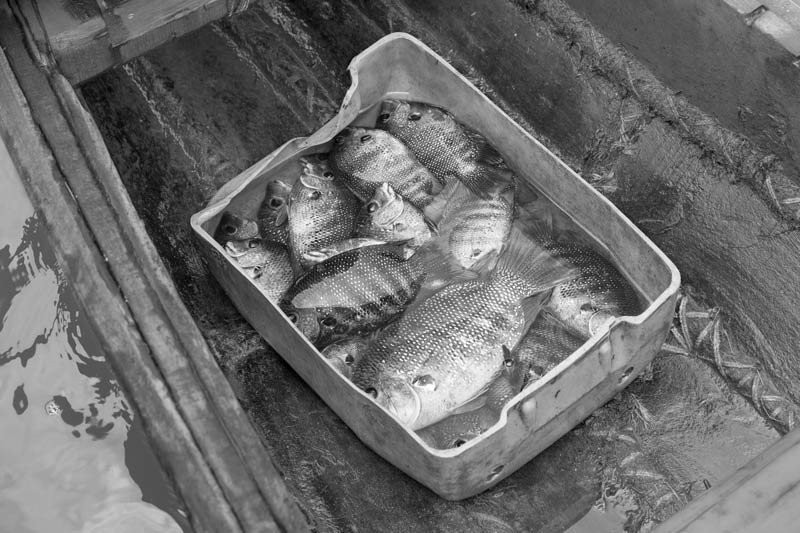
A catch of Karimeen from Vambanad Lake in Alappuzha district, Kerala
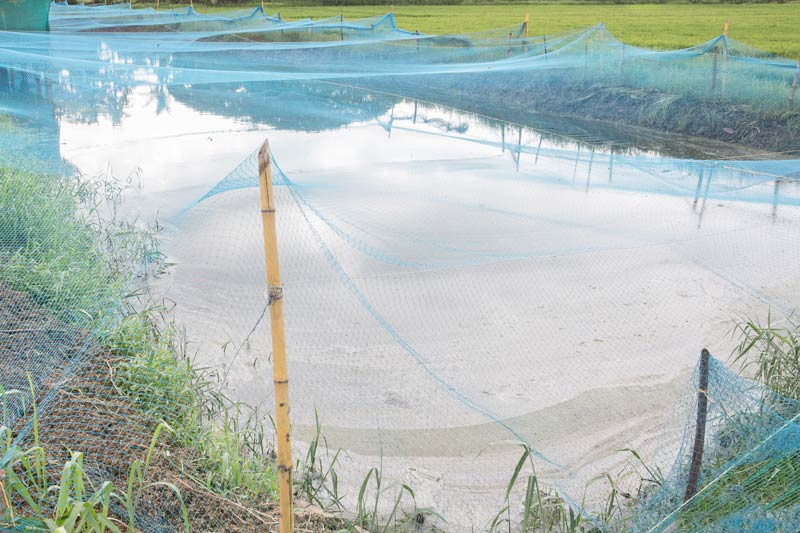
Fish farming in paddy fields in Alappuzha district, Kerala
Fish farming in the paddy fields is being increasingly practiced in Kuttanad where after the main paddy crop punja, making use of the water abundance in the fields and the surrounding channels, a fish crop is raised between March and October. Varieties like catfish and carp are commonly farmed and are sold locally as well as exported to other States and outside. The paddy fields may be leased out by farmers to fishermen for the purpose.
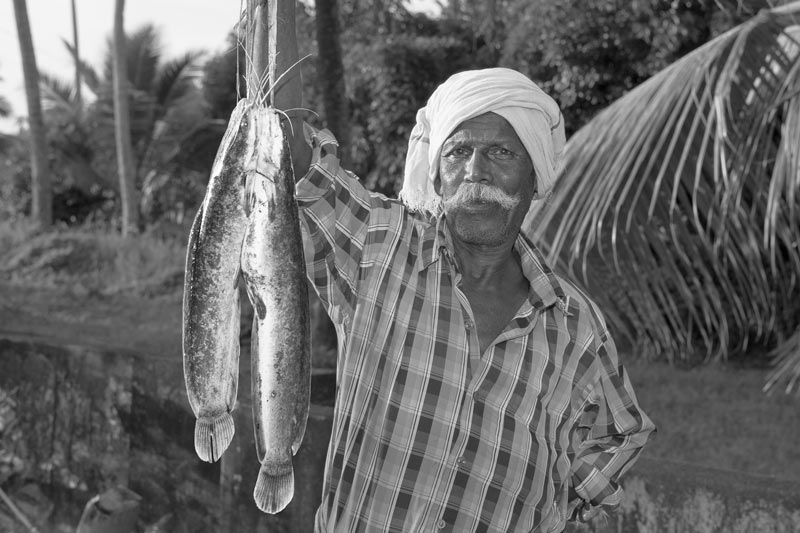
Walking Catfish (Clarias batrachus), commonly farmed in paddy fields and harvested from shallow channels, rivers and large ponds in Alappuzha district, Kerala
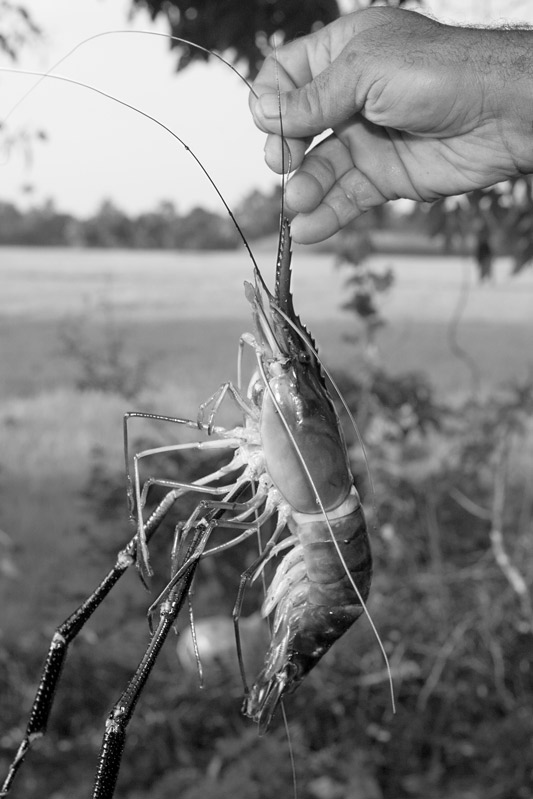
A giant freshwater prawn in Alappuzha district, Kerala
Kuttanad is the home ground of giant freshwater prawn (Macrobrachium rosenbergii), consumed locally as well as exported to other States and abroad. It grows up to the size of 40 cm and is locally known as 'Kuttanadan konchu' or 'Attu konchu'. Though the prawn is found in the natural waters of Vembanad Lake, its farming is also being increasingly adopted in paddy fields, homestead ponds and water channels inside coconut plantations. Of these, their farming in paddy fields is the most common. It is mostly done on a rotational basis, alternating one paddy crop with one round of prawn farming done mostly from March to October. Around 5,000 ha of paddy fields are estimated to be utilized for prawn farming at present. Profit for the farmers is good, estimated to range from Rs. 5,000 to Rs. 20,000/ha (1 USD = approx. 71 Indian Rupees).
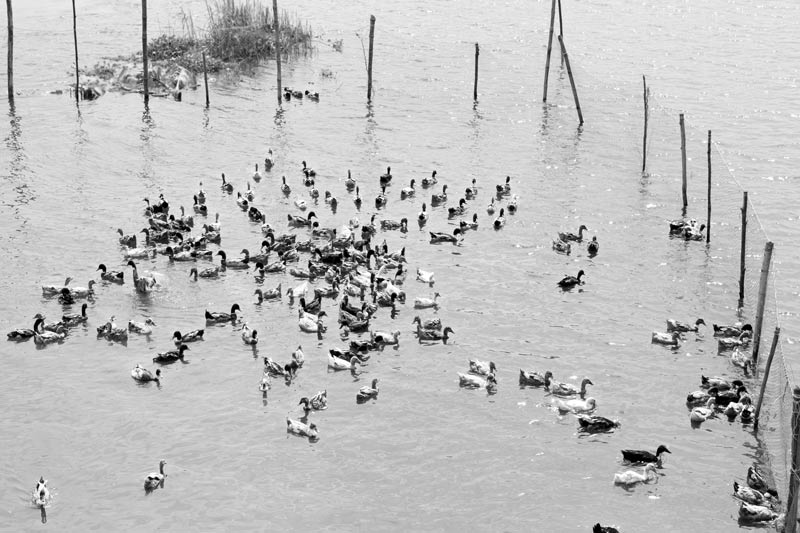
A flock of ducks reared in the wetlands of Kuttanad in Alappuzha district, Kerala
Another popular and profitable source of livelihood that utilizes the water abundance in Kuttanad is duck farming. Ducks wading through canal waters and flooded paddy fields is a common sight in the region. Immediately after harvest of paddy, paddy farms are leased out to duck rearers who come from even distant places, and one duck rearer may own anywhere between 2,000 to 10,000 or even more ducks. The practice mutually benefits the duck rearer and paddy farmer. The ducks feed on the fallen-off grains and small fish in the waters, while their droppings help enhance the field's fertility. In the past, the duck rearers paid the farmers in kind, in terms of meat and eggs in exchange for the use of their land for duck rearing, but now cash transactions are more common. According to the duck rearers, the expenditure on each duck is very little (around Rs. 50) before they reach the saleable age, but the meat gets a good price of over Rs. 300 per kilo (1 USD = approx. 71 Indian Rupees). Even duck eggs are sold at a good price of more than Rs. 6 per piece. Apart from bringing profits to the paddy farmers and duck rearers, duck farming also provides gainful employment to many who live around the canals of Kuttanad.
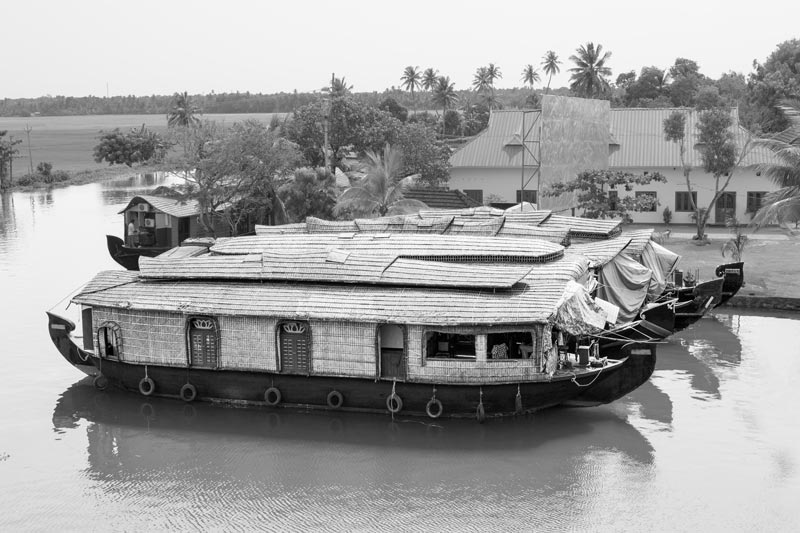
Houseboats, the most attractive component of backwater tourism, boosting local incomes in Alappuzha district, Kerala
In recent decades, a new mode of livelihood flourishing in Kuttanad that utilizes the water abundance is tourism. Given the serene beauty of the waterscapes and the unique lifestyle of the region, Kuttanad has become a center of backwater tourism, the most popular activity being houseboat tourism. The traditional boats called 'Kettuvalams', commonly about 30 m in length, having thatched roof covering over wooden hulls, and used in the past as grain barges to transport rice harvested from the paddy fields, have been converted into floating cottages for tourists. Development of backwater tourism sector in general, and houseboat tourism in particular, has resulted in increased employment opportunities for Kuttanad residents. According to government estimates, this forms an economic base for nearly 85,000 households. Each boat employs usually 3–5 persons, and according to one estimate, one or two members from each household are now engaged in the sector as houseboat operators or other employment related to the houseboat.
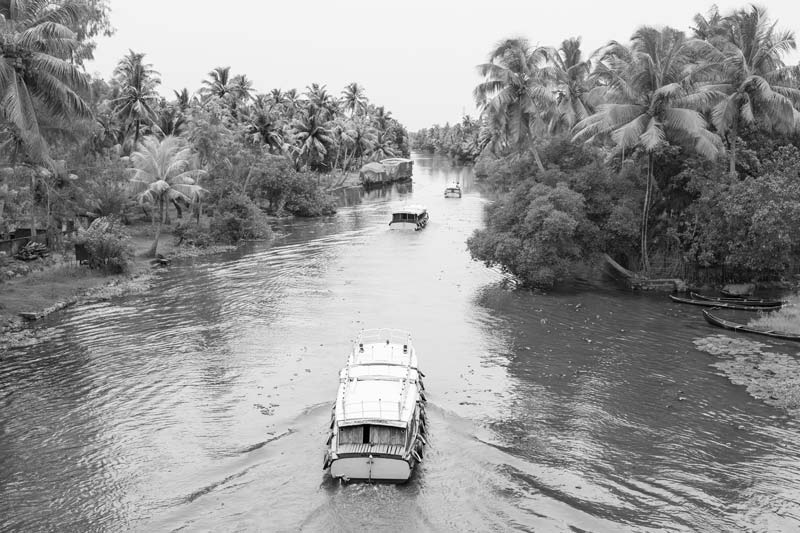
Motorized tourist boats in the Kuttanad waterways in Alappuzha district, Kerala
Apart from houseboats that are rented out for longer night trips, many tourists also enjoy shorter trips on motorized boats that ply through the narrow water canals of Kuttanad and Vembanad Lake. This activity also gainfully employs local persons from the region.
This photo story has illustrated how the people who settled in Kuttanad – the hostile wetlands lying below the sea level – learnt to manage the water abundance around to enable themselves to practice agriculture and other kinds of profitable livelihoods. The knowledge and practices in this regard ranged from creating arable land out of the vast waterscapes to utilization of the water abundance to create a unique agricultural system that combines paddy farming with horticulture, fishing and duck farming, ultimately producing food as well as incomes locally. They even developed water-based economic activities like fishing in the lake and watercourses and backwater tourism that make use of the existing natural water abundance. It is a classic example of how through human ingenuity, persistent efforts and use of local resources and knowledge, resilience to inherently hostile environments can be built, leading to socio-economic prosperity. The livelihoods practiced by the Kuttanad inhabitants offer important lessons for the rest of the country and the world, particularly in the era of global warming and its effects in the coastal areas, primarily in the form of a rise in the sea level. The multifaceted 'Kuttanad Wetland Agriculture System' developed in the face of water abundance below the sea level demonstrates efficient mechanisms that can be adopted as adaptations to sea level rise. It presents strong evidence of how diverse agro-based livelihoods can be profitably organized by constructing embankments and polders instead of migration in the face of coastal submergence resulting from sea level rise. It also offers examples of water-based livelihoods that can be adopted as alternatives to land-based ones. According to M.S. Swaminathan Research Foundation, India, which was instrumental in helping the 'Kuttanad Below Sea Level Farming System' receive the status of 'Globally Important Agricultural Heritage System', island States like Maldives and coastal countries like Bangladesh have already expressed deep interest in replicating the Kuttanad model in an effort to adapt to climate risks resulting from sea level rise. Even Indian coastal areas are progressively affected by sea level rise. There is need to learn from the Kuttanad model and build resilient livelihoods and societies in these areas. However, there is need to exercise caution and use the Kuttanad model for adaptation to submergence from sea level rise, and not for promoting human colonization within living natural wetlands, as this may adversely affect the sustainability of existing ecosystems and therefore human society.